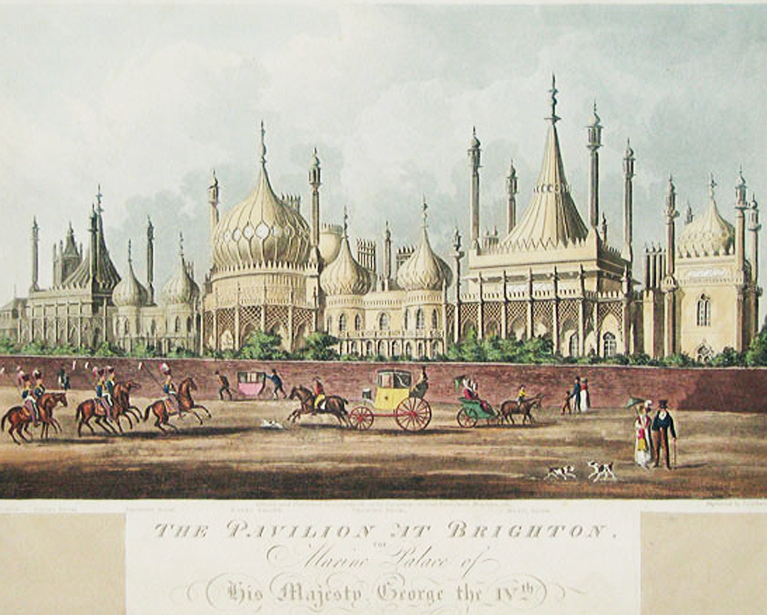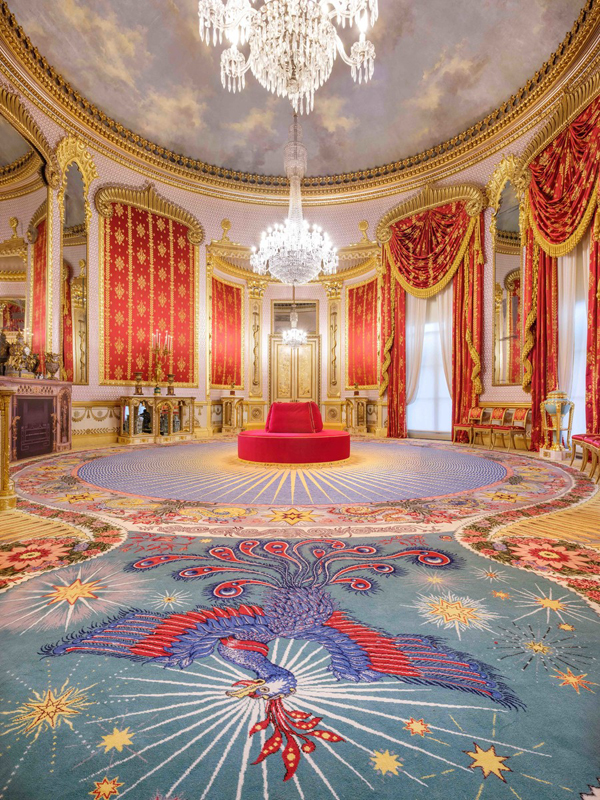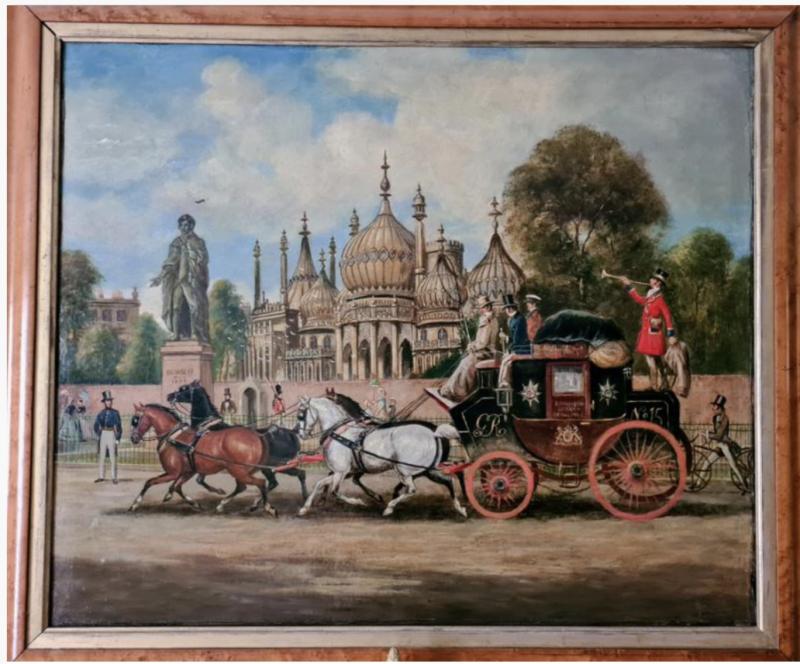Another Reason To Visit Brighton-by-the-Sea This Summer. To Visit the Magnificent Pavilion Palace & View ‘The Encampment At Brighton’, by Francis Wheatley, RA, 1747-1801. Which We Were Most Proud To Assist & Enable It’s Donation to Brighton 50 Years Ago
Two years ago we celebrated the completion of a multi million pound three year restoration of the main saloon in the Royal Pavilion palace in Brighton, and we are continually humbled to know that our family donation enabled the premier work of art, of a depiction of an hussars regiment, encamped in the hills above Brighton, by Francis Wheatley RA, and thus to be saved for posterity for the Brighton Museum collection.
Possibly their most famous work of art, certainly one of their best. 'The Encampment at Brighton', is a major work by Francis Wheatley RA (1747?1801). (b London, 1747; d London, 28 June 1801). A most fine English painter of his day in the reign of King George IIIrd. His early works were mainly small full-length portraits and conversation pieces in the manner of Zoffany. In 1779 he moved to Dublin to escape creditors, and after his return to London in 1783 his work broadened in scope. It included landscapes, history paintings, and life-size portraits, but he is best known for works produced to be engraved for the Georgian print market. His works now reside in the government collection, the Royal Collection and many of the finest museums and collections around the country.
We were delighted to have enabled its acquisition, back in 1973, and over the past few decades we have been pleased to know of its permanent presence in the City collection, saved for posterity and enabling the museums visitors to view this magnificent work based and painted in Brighton in the 1790's.
Any visitors to Brighton this summer, who make a visit to our world famous store, The Lanes Armoury, ought to consider visiting Brighton Museum as part of your visit, in order to view its superb collection, and especially visit our magnificent Royal Pavilion, former summer palace of King George IVth, {former the Prince Regent} donated to Brighton by Her Majesty Queen Victoria, and considered today, by many, to be the most wonderful palace of its kind in the world.
A joyous combination of Indo-Chinese architecture and fine art. A magnificent example of the Royal Family’s diversity, 200 years before the word even became known, and as so significant as it is today.
Brighton has been for centuries a long exponent of diversity, and without doubt certainly one of the best most loved and diverse cities in the entire world. For example, during World War I, the Royal Pavilion palace’s royal stables, that later became the world famous Dome Theatre, was turned over to become a hospital for the desperately wounded, heroic, Indian, volunteer soldiers, it is said that many Indian soldiers when they recovered consciousness and awoke in the palace, believed they had died and gone to heaven, which was a recreation of an Indian Palace.
It was almost 60 years later The Dome Theatre was the host venue of ABBA’s very first public explosion on to the world stage, in fact Mark, {the Lanes Armoury’s elder partner} was coincidentally there in person, just outside the stage area, listening to their very first hit, Waterloo, {somewhat ironic with our Waterloo interest} at the Eurovision Song Contest over 50 years ago.
The Royal Pavilion contains some of the finest and most magnificent Chinoiserie works of art to seen anywhere in the world. Some of the original Prince’s treasures were, very recently, just returned from the Buckingham Palace Royal Apartments, to be once more placed on display in the Royal Pavilion in Brighton, as one of the last, and personal benevolent instructions of Her Late Well Beloved Majesty Queen Elizabeth IInd. In order that once more, our city, and it’s millions of visitors, can enjoy the fabulous royal treasures in their original, former, location, the magnificent home of the Prince Regent.
Somewhat like us at The Lanes Armoury, the Royal Pavilion is certainly not one of the largest of the world’s Royal Palaces, in fact, it is possibly one of the smallest, but it is considered, by many, to be the very best.
We also show in the gallery a painting by Richard {Dickie} Compton, commissioned by our family from the artist, of our Holland & Holland, London to Bath and Wells, Royal Mail Road Coach, passing in front of the statue of The Prince Regent, which itself is in front of the Royal Pavilion. The road coach, later photographed, still in use in 1969, outside of the gates to the Royal Pavillion, and the oil painting are part of the late Camilla Hawkins Collection.
As like many Brightonians, our personal family connections to the palace go back since it was first built, over two hundred years ago. Our family used to supply shellfish from the shores off Brighton for His Majesty’s table {we held the shellfish concession for many decades in the 18th and 19th century}. A family member worked in the staff -a very lowly position naturally, bearing in mind, our family history, always was, and still is, in ‘trade’, once considered by 19th century ‘society’ to be, at the time, as not particularly in much higher regard than *coster mongers-. We later owned the annex of the Royal Stables, a stable yard around 100 yards from the palace, now demolished and on the site of the current My Hotel in Jubilee Street. And in the early 1970’s Mark purchased from an elderly farmer in the North, the original huge pump organ made for the Prince Regent’s music room in the palace. But it was either never installed, or, if it was, it was not much later removed by Queen Victoria, and sold off. When Mark bought it, it had the original schematic and plans for installation, which were magnificent in their beauty and detail, somewhat like the architects plans much have been for the original palace. We offered to donate it to the Palace Trustees in the 1970’s, but it was refused as impractical to re-install, unless we paid for its installation, but the cost involved would have been prohibitively astronomical. So, we sold it to an Australian diocese instead, and apparently it was installed not much later in an Australian Cathedral.
* coster monger or hawker, A costermonger, coster, or costard was a street seller of fruit and vegetables, sometimes fish, in British towns. The term is derived from the words costard (a medieval variety of apple) and monger (seller), and later came to be used to describe hawkers in general. In fact our family name, Hawkins, was a medieval derivative from Hawker, which would therefore, have been our family trade and social position in the post Roman occupation era. Pretty low down the social scale, before our family moved to Plymouth, and our seafaring nature brought some element of success, and thus the elevation with a knighthood for Sir John Hawkins, and Sir Francis Drake, his cousin, who was later Admiral for Queen Elizabeth Ist. Drake was John’s cousin due to being adopted by William Hawkins, famed seafarer of Plymouth, and thought to have been adopted, as possibly being his bastard son.
Sir Francis Drake's heraldic achievement and coat of arms contains the motto, Sic Parvis Magna, which means: "Great achievements from small beginnings". Drake became the first Englishman to navigate the Straits of Magellan, a sea route at the southern tip of South America linking the Atlantic and Pacific oceans
Code: 21652
Price
on
Request






